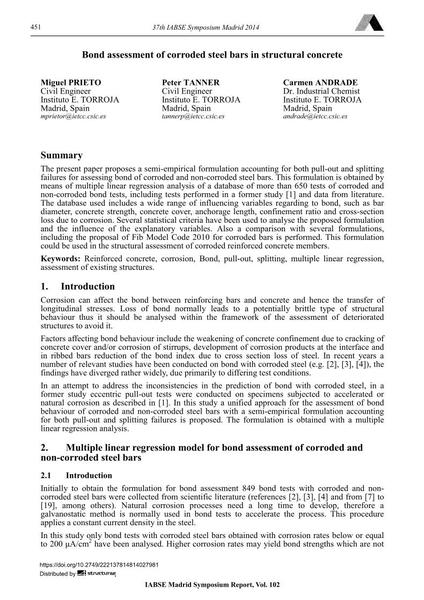Bond assessment of corroded steel bars in structural concrete

|
|
|||||||||||
Bibliografische Angaben
| Autor(en): |
Miguel Prieto
Peter Tanner Carmen Andrade |
||||
|---|---|---|---|---|---|
| Medium: | Tagungsbeitrag | ||||
| Sprache(n): | Englisch | ||||
| Tagung: | IABSE Symposium: Engineering for Progress, Nature and People, Madrid, Spain, 3-5 September 2014 | ||||
| Veröffentlicht in: | IABSE Symposium Madrid 2014 | ||||
|
|||||
| Seite(n): | 451-458 | ||||
| Anzahl der Seiten (im PDF): | 8 | ||||
| Jahr: | 2014 | ||||
| DOI: | 10.2749/222137814814027981 | ||||
| Abstrakt: |
The present paper proposes a semi-empirical formulation accounting for both pull-out and splitting failures for assessing bond of corroded and non-corroded steel bars. This formulation is obtained by means of multiple linear regression analysis of a database of more than 650 tests of corroded and non-corroded bond tests, including tests performed in a former study [1] and data from literature. The database used includes a wide range of influencing variables regarding to bond, such as bar diameter, concrete strength, concrete cover, anchorage length, confinement ratio and cross-section loss due to corrosion. Several statistical criteria have been used to analyse the proposed formulation and the influence of the explanatory variables. Also a comparison with several formulations, including the proposal of Fib Model Code 2010 for corroded bars is performed. This formulation could be used in the structural assessment of corroded reinforced concrete members. |
||||
| Stichwörter: |
Korrosion Stahlbeton
|
||||
